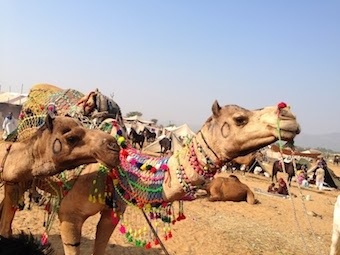
Horsing and Cameling Around at the Pushkar Fair
By Donna Shaver
The Pushkar Fair, also known as the Pushkar Cattle Market or the Pushkar Camel Fair, is a world famous event. It is held annually in the month of Kartika (October/November) ten days after the festival of Diwali. The Pushkar Fair is one of the largest cattle markets in all of Asia, and a major attraction for visitors to India.
To the outside world, it is a market and fair, but to millions of Hindus, it is a religious pilgrimage. On our way to the fair, we passed many buses and trucks crammed with colorfully clad pilgrims. Pushkar is a sacred city, believed to have been created by the Lord Bramha himself. The name Pushkar comes come from pushpa (flower) and kar (hand) because legend says that the lakes were created from the petals that fell from his hand. There are over 400 temples and shrines around its holy lake. In addition to a temple to Lord Bramha, there are temples to Gayatri, Savitri, Shiva, and Badri Narayan. Dipping in the holy water of the lake is believed to bestow salvation, Although we would have loved to visit the lake, it was a long walk and time was short.
It was a short drive from our hotel in Ajmer. We left our bus and boarded two camel-drawn carts, The carts have a platform, about five feet square and are covered with colorful quilts. Each has a canopy for shade, and two truck tires. The platform slopes to the back. We pile on, sitting as best we can, some of us around the sides and back of the platform with legs hanging over the edge. Those at the front found themselves uncomfortably close to an enormous camel posterior–but that was soon forgotten as we were immediately engrossed in the action.
The fair itself is quite the spectacle. As far as the eye can see, there are livestock and tents, vendors and hawkers. The earth is bare and dusty, with nary a blade of grass. The land is gently rolling, and in the distance we could see the tops of a structure or two, perhaps temples.
The first half of our leisurely ride was through the area where the horses were on display–thousands of them, and all meticulously groomed. They were mostly splendid animals, although I found myself disturbed by a surprising number of malnourished horses, ribs showing and heads hanging. The horses were all of a type unfamiliar to me–their ears were slender, and curved toward each other, usually touching at the tips. Many were black and white, but a variety of colors were represented . There was an area of all albino horses. At the end of one row of these dazzling white horses was a magnificent shiny black horse. I adore horses, so I was truly in horse heaven!
Next came the camels–also in the thousands. We have encountered camels throughout our journey. Camels pull carts even in Delhi, but the camel ratio increased significantly when we entered Rajasthan. In Jaipur, Agra, Ajmer and every tiny settlement in between, camels were common–often standing or lying near shops and dwellings. Camel carts were common, and occasionally we would see someone riding on a camel.
To my unpracticed eye, they look all the same, but in fact there are three varieties of camel in Rajasthan–Bikaneri camels (hairy ears, great load bearing capacity, and stamina), Jaisalmeri camels (longer legs, can cover up to 14 miles an hour), and Gujarati camels (darker haired and adept at walking in marshy areas). Who knew?
